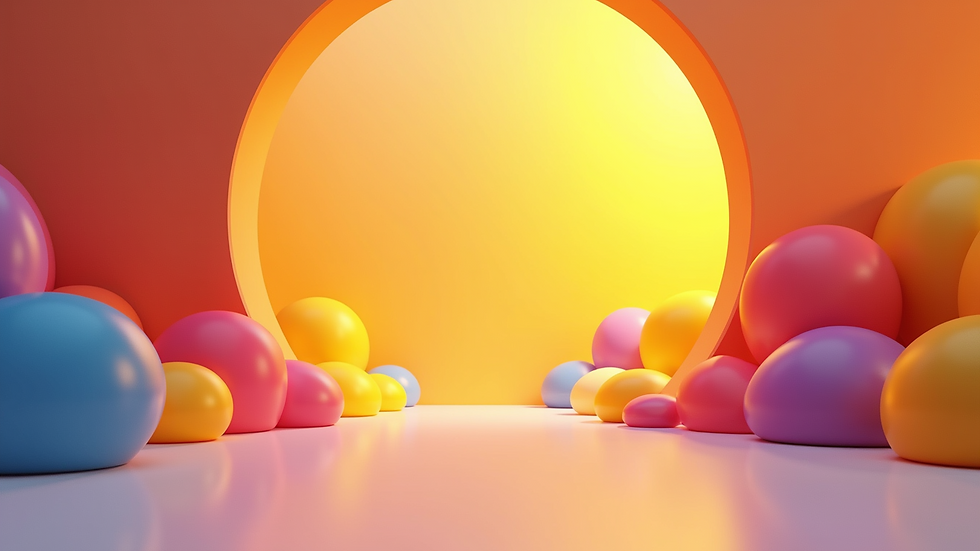Top Digital Design Trends for 2025
- jrobinette

- Oct 27
- 4 min read
Digital design is evolving faster than ever, and 2025 is shaping up to be an exciting year for creatives and enthusiasts alike. Whether you’re a designer, marketer, or just someone who loves fresh ideas, knowing the latest trends can help you stay ahead of the curve. This year, digital design is all about blending creativity with technology in ways that feel natural, engaging, and downright fun.
Let’s dive into the top digital design trends for 2025 that are making waves and inspiring new ways to create.
Bold Colors and Gradients Take Center Stage
One of the most noticeable trends this year is the return of bold, vibrant colors. Designers are moving away from muted palettes and embracing bright hues that grab attention and evoke emotion. Think electric blues, fiery reds, and neon greens paired with smooth gradients that add depth and dimension.
Gradients are no longer just backgrounds; they’re being used in logos, buttons, and even typography to create a dynamic look. This trend works great for brands wanting to stand out and make a memorable impression.
How to use this trend:
Combine two or three bold colors in a gradient for backgrounds or overlays.
Use gradients on text to add a modern twist.
Pair bright colors with simple shapes to keep the design balanced.
This approach not only energizes your design but also helps guide the viewer’s eye to important elements.

Digital Design Trends Embrace Minimalism with a Twist
Minimalism has been popular for years, but in 2025, it’s getting a fresh update. Instead of plain and simple, minimalism now includes playful elements like asymmetry, unexpected shapes, and subtle animations. This keeps designs clean but adds personality and movement.
Designers are using white space smartly to create breathing room while incorporating small details that surprise and delight users. This trend is perfect for websites and apps that want to feel modern but approachable.
Tips to try this trend:
Use asymmetrical layouts to break the grid and add interest.
Add micro-animations to buttons or icons for interactivity.
Keep color palettes simple but introduce one or two accent colors.
This style helps users focus on content without feeling overwhelmed, making it easier to communicate your message clearly.

What does a digital creator do exactly?
If you’ve ever wondered what a digital creator actually does, here’s a quick breakdown. A digital creator is someone who produces content using digital tools and platforms. This can include graphic design, video production, animation, web design, and more. They bring ideas to life through various forms of media that are shared online or through digital channels.
Digital creators often blend art and technology to craft engaging experiences. They might design a website, create social media graphics, or develop interactive content. Their work is essential in shaping how brands communicate and connect with audiences in the digital world.
Key roles of a digital creator:
Conceptualizing ideas based on client or project needs.
Using software like Adobe Creative Suite, Figma, or Blender to create visuals.
Collaborating with marketers, developers, and other creatives.
Staying updated on trends to keep their work fresh and relevant.
3D and Immersive Design Are Going Mainstream
3D design is no longer just for big-budget projects. Thanks to better tools and faster computers, 3D elements are popping up everywhere—from websites to apps and even social media posts. These designs add realism and depth, making digital experiences more immersive.
In 2026, expect to see more 3D illustrations, interactive product models, and virtual environments. This trend helps brands showcase products in a lifelike way and keeps users engaged longer.
How to incorporate 3D design:
Use 3D icons or illustrations to add dimension to flat layouts.
Create interactive 3D product views for e-commerce sites.
Experiment with AR (augmented reality) features to blend digital and real worlds.
This trend is perfect for anyone looking to make their digital presence feel cutting-edge and memorable.
Nostalgia Meets Modern Design
Nostalgia is a powerful emotion, and designers are tapping into it by blending retro styles with modern techniques. Think pixel art, neon signs, and vintage typography combined with sleek layouts and contemporary colors.
This mix creates a unique vibe that feels both familiar and fresh. It’s a great way to connect with audiences who appreciate the past but want something new.
Ways to use nostalgia in your design:
Incorporate retro fonts with modern color schemes.
Use pixelated graphics or 80s-inspired neon effects.
Combine old-school patterns with clean, modern grids.
This trend works well for brands wanting to evoke emotion and tell a story through their visuals.
Motion and Micro-Interactions Make Designs Come Alive
Static designs are out, and motion is in. Adding subtle animations and micro-interactions can make a huge difference in how users experience a website or app. These small movements guide users, provide feedback, and add a layer of delight.
In 2026, expect to see more hover effects, animated icons, and smooth transitions that make digital spaces feel alive and responsive.
Practical tips for motion design:
Use animations to highlight calls to action.
Add hover effects to buttons and links for better interactivity.
Keep animations subtle to avoid distraction.
Motion design not only improves usability but also creates a memorable experience that keeps users coming back.
Digital design in 2025 is all about creativity, engagement, and blending the old with the new. Whether you’re experimenting with bold colors, diving into 3D, or adding a touch of nostalgia, there’s something exciting for every creator. Keep exploring, stay inspired, and don’t be afraid to push the boundaries of your digital creations.

Ready to take your designs to the next level? Keep an eye on these trends and watch your work shine in the digital world!



Comments